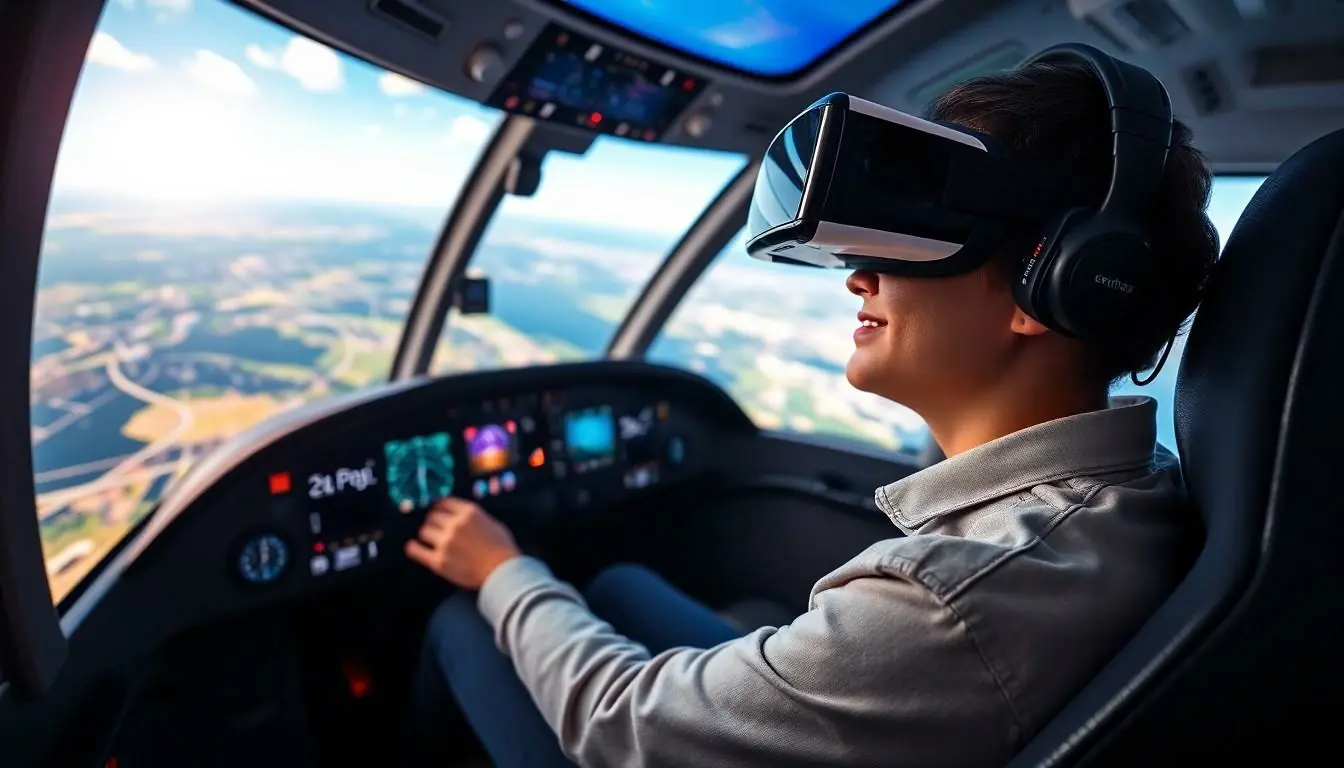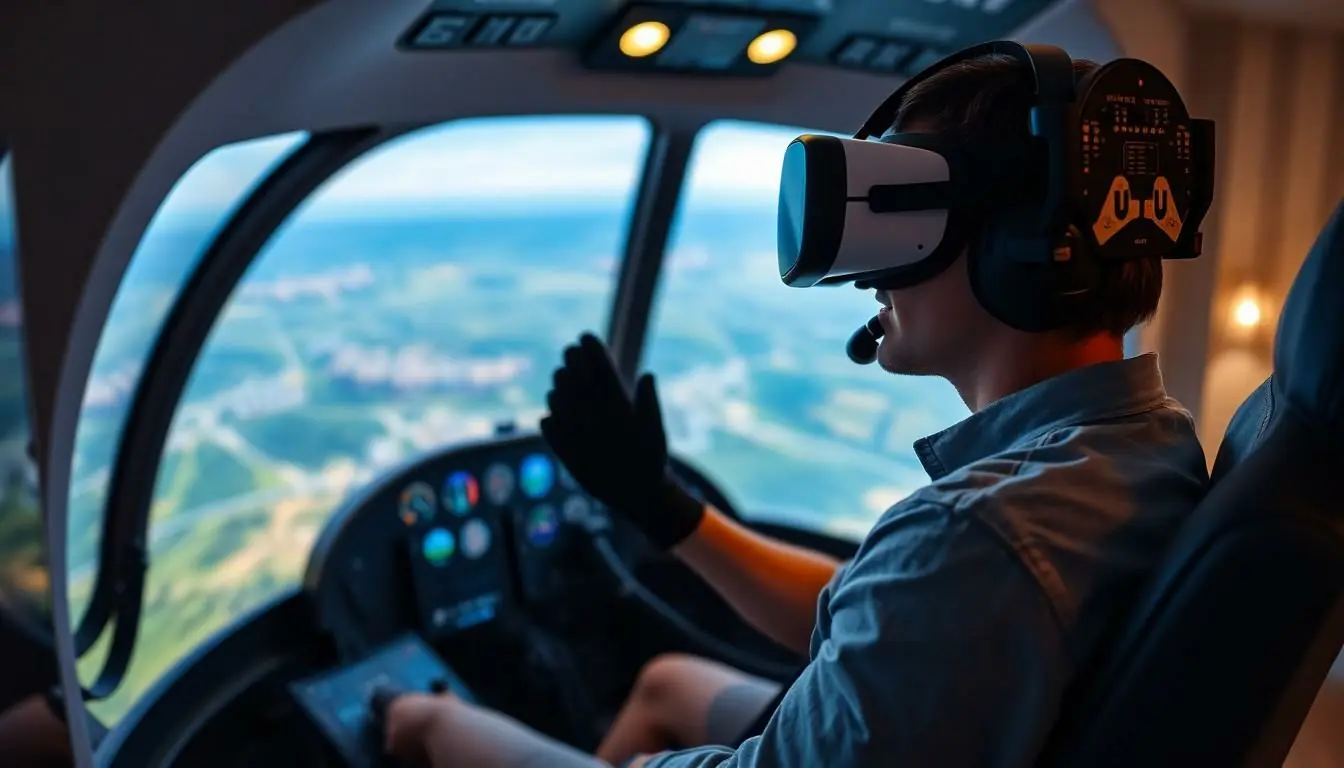Imagine soaring through the skies, feeling the rush of wind as you navigate a sleek aircraft—all from the comfort of your living room. Virtual reality flight simulators make this dream a reality, offering a thrilling experience that’s just a headset away. Whether you’re a budding aviator or someone who just wants to escape the daily grind, these simulators turn the mundane into the magnificent.
Table of Contents
ToggleOverview of Virtual Reality Flight Simulators
Virtual reality flight simulators create immersive experiences that replicate the sensations of flying. These systems utilize advanced technology to simulate cockpit environments and aircraft performance. Users can explore various aircraft models, ranging from small private planes to massive commercial airliners.
Enhanced graphics and sound technologies contribute to realism, allowing users to enjoy dynamic weather conditions and different environments. With this technology, users engage in activities like flight training, aerial tours, or scenic explorations. Popular software options include Microsoft Flight Simulator and X-Plane, both offering extensive libraries of aircraft and flight scenarios.
Many simulators support VR headsets, elevating the immersion level. Full-motion platforms further enhance experiences by providing physical feedback during flight maneuvers. Players can practice landing in different terrains, navigating through complex air traffic systems, or simply experiencing the thrill of soaring through the sky.
User communities often share their experiences, offering tips and modifications to improve realism. This sharing fosters a collaborative atmosphere where enthusiasts can discuss techniques, challenges, and achievements. Online platforms host challenges, encouraging pilots to test their skills against others globally.
Cost-effective high-quality simulations are accessible, making flight training more affordable and practical. Training programs utilize these simulators for pilot certifications, allowing users to build hours of flight experience in a controlled environment. By integrating real-world airline operations into the simulations, users gain valuable insights into aviation dynamics.
Overall, virtual reality flight simulators represent a significant advancement in interactive entertainment and pilot training, appealing to a wide range of users.
Key Features of Virtual Reality Flight Simulators

Virtual reality flight simulators offer a range of key features that enhance the flying experience. Immersion remains a central aspect.
Immersive Experience
Engaging visuals transport users into lifelike environments. VR headsets create a 360-degree view of cockpits and landscapes. Sound design replicates engine noise and external weather effects, deepening engagement. Multiple aircraft models provide varied experiences, encouraging exploration of different flight perspectives. Users feel sensations like acceleration and turbulence, making every flight feel real. Overall, immersive elements significantly enhance enjoyment and realism.
Realistic Physics
Physics engines in simulators mimic actual aircraft behavior. Aerodynamics play a critical role in flight dynamics, affecting climb rates and stall conditions. Real-time weather changes create challenges that pilots must navigate. Ground effects influence takeoff and landing, adding to the authenticity. Each aircraft’s unique handling characteristics ensure realistic flight experiences. Accurate physics modeling supports various flight maneuvers, making training highly effective.
Control Systems
Control systems in virtual reality flight simulators mirror real-world cockpit interfaces. Joysticks, yokes, and throttle quadrants allow for intuitive operations. Advanced settings enable customization of controls, catering to user preferences. Many simulators integrate multi-monitor setups for enhanced situational awareness. Complex navigation systems present challenges that reflect actual airline operations. Realistic interaction with avionics promotes skill development and familiarity with aircraft systems.
Popular Virtual Reality Flight Simulators
Various flight simulators capture the essence of aviation, offering unique experiences tailored to different preferences and skill levels.
Simulator A
Microsoft Flight Simulator stands out as a premier choice in the virtual reality flight simulator market. Its stunning graphics recreate detailed landscapes and iconic landmarks. Users can fly over real-world locations with incredible realism, exploring diverse weather systems. The simulator includes numerous aircraft options, ranging from general aviation planes to commercial jets. Enhanced VR support allows pilots to engage deeply with the cockpit environment, creating an immersive experience. Community challenges further enrich the experience, inviting users to showcase their flying skills globally.
Simulator B
X-Plane offers a robust alternative, focusing on realism and user-centered customization. Its flight physics engine accurately reflects real-world aircraft behavior, fostering an authentic flying environment. Users can modify existing aircraft or create entirely new designs, enhancing the simulation experience. Support for VR headsets amplifies immersion, allowing pilots to feel every maneuver. A diverse selection of downloadable content provides additional aircraft and scenery options, catering to varying levels of expertise. Realistic air traffic simulation adds another layer of complexity, challenging pilots as they navigate busy skies.
Simulator C
DCS World is another notable simulator, targeting enthusiasts seeking military aviation experiences. This simulator emphasizes combat situations, offering an array of military aircraft with realistic flight dynamics and systems. Missions offer opportunities to engage in air-to-air and air-to-ground combat scenarios. Virtual reality integration enhances the intensity of battle situations, allowing pilots to interact with controls seamlessly. Persistent updates and community-generated content consistently add new features and missions, ensuring a dynamic flying experience. The focus on detail and realism makes DCS World a preferred choice for users interested in military simulations.
Benefits of Using Virtual Reality Flight Simulators
Virtual reality flight simulators offer numerous advantages for users. Enhanced immersion stands out as a primary benefit. With VR headsets, users experience a 360-degree view of their environment, making flying feel more realistic. Engaging graphics and spatial audio further contribute to this immersive experience, simulating sounds of engines, weather effects, and cockpit controls.
Skill development becomes significantly more accessible with these simulators. Users can practice various flight maneuvers in a safe, controlled environment without the risks associated with real flying. Training programs incorporate these simulators for pilot certifications, helping aspiring aviators hone their skills effectively.
Cost-effectiveness represents another critical advantage. Virtual reality flight simulators provide an affordable alternative to traditional flight training, allowing users to explore aviation without a large financial commitment. Many simulators include a variety of aircraft models, from small private planes to commercial airliners, broadening user experience and training opportunities.
Community engagement plays a vital role in this virtual realm. Users connect through online platforms, sharing tips, experiences, and modifications. Challenges against other pilots worldwide encourage friendly competition and skill testing. This sense of community enhances the overall experience, making virtual flying a shared adventure.
Finally, adapting to real-world conditions becomes easier with advanced technologies. Simulators integrate dynamic weather patterns, varying terrains, and complex air traffic systems, allowing users to face realistic scenarios. Navigating these challenges builds confidence for real-world flying, setting a strong foundation for success in aviation.
Challenges and Limitations
Virtual reality flight simulators face several challenges and limitations that impact their effectiveness. Hardware requirements can create accessibility issues, as high-quality VR headsets and powerful computers often involve substantial investment. Users with limited budgets may struggle to acquire the necessary equipment to experience these simulations fully.
Another constraint involves realism. Although current technology provides immersive environments, it doesn’t perfectly replicate all aspects of flying. Users may encounter discrepancies in flight dynamics or environmental conditions, which can hinder the training experience. Some simulators might lack detailed procedures for specific aircraft models, limiting training opportunities for aspiring pilots.
Software bugs also present a challenge. Developers frequently release updates, but users may still face crashes or glitches that disrupt the flying experience. Subpar performance can diminish immersion and frustrate users seeking realistic simulations.
Multiplayer features introduce additional obstacles. Network connectivity issues can affect online interactions, leading to latency or disconnections. Users might miss out on community engagement opportunities due to unreliable internet connections.
Finally, the learning curve for novice users can prove steep. While some individuals quickly adapt to controls and interface, others may find the complex systems intimidating. Differences in prior experience with flight simulators further influence the ease of entry for newcomers.
Despite these challenges and limitations, the benefits of virtual reality flight simulators continue to captivate a growing audience. Users increasingly seek out solutions to overcome these hurdles while enjoying the thrills of flight simulation.
Virtual reality flight simulators have redefined the way enthusiasts experience aviation. By combining advanced technology with immersive environments, they offer users the chance to soar through the skies without leaving home. These simulators cater to a diverse audience, from aspiring pilots to casual gamers, and provide a unique blend of entertainment and education.
Despite some challenges, the advantages of virtual reality flight simulators are undeniable. They promote skill development in a safe setting while fostering community engagement among users. As technology continues to evolve, these simulators will likely become even more accessible and realistic, ensuring that the thrill of flight remains within reach for everyone.

